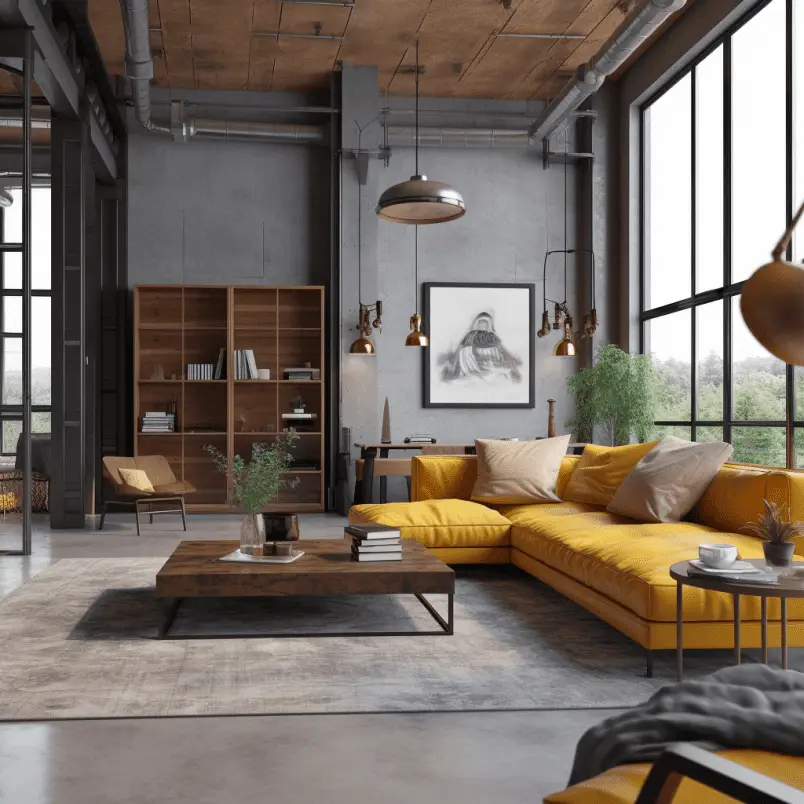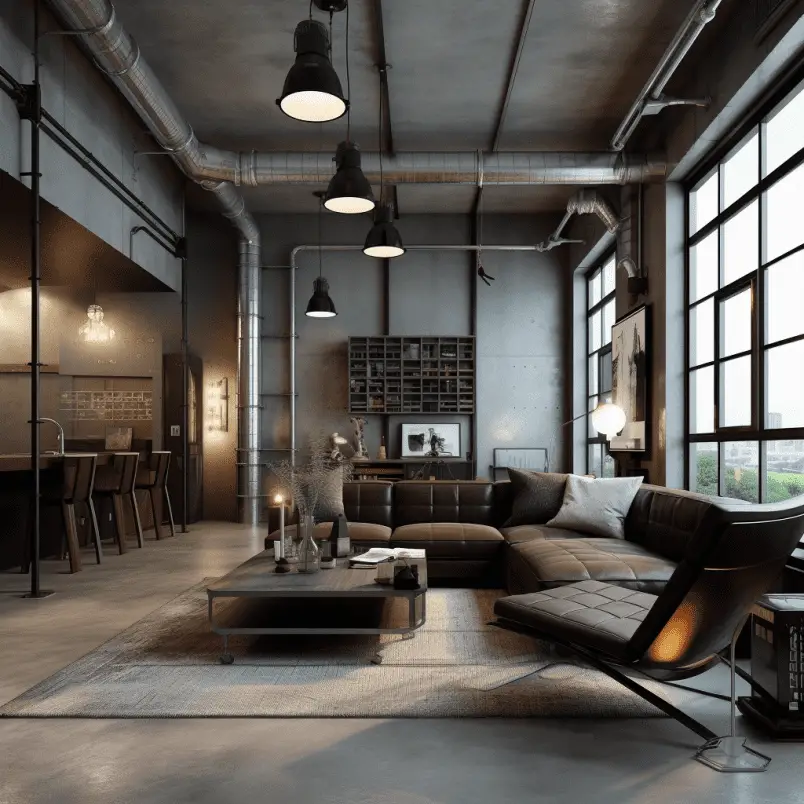Welcome to our guide on industrial interior design! As experts in the field, we’re excited to share with you everything you need to know about this popular style of design.
Industrial interior design is a style that originated in the early 20th century when factories and warehouses were converted into living spaces. It has since become a popular choice for homes, offices, and public spaces. At its core, industrial design is all about embracing raw, unrefined materials and turning them into something beautiful.
In this guide, we’ll take a closer look at what makes industrial interior design so unique, as well as some tips for incorporating this style into your own space.

Table of Contents
What is Industrial Interior Design?
Industrial interior design is all about celebrating the beauty of raw materials. It often features exposed brick, concrete, and metal, as well as reclaimed wood and other natural elements. This style is characterized by its rugged, unfinished look, which gives it a sense of authenticity and history.
One of the key features of industrial design is the use of neutral colors, particularly shades of gray, black, and white. This creates a minimalist aesthetic that allows the materials and textures to take center stage. However, pops of color can be added through artwork, accessories, or furniture to add interest and depth to the space.

Elements of Industrial Design
When it comes to industrial interior design, there are a few key elements that are often incorporated into the space. These include:
Exposed brick
One of the hallmarks of industrial design, exposed brick adds warmth and texture to a space. Whether it’s a full brick wall or just a few bricks here and there, it’s a great way to add character and personality to a room.

Concrete
Another common feature of industrial design is the use of concrete. From floors to countertops, concrete is a durable and versatile material that works well in this style.

Metal accents
Whether it’s in the form of light fixtures, furniture, or decorative pieces, metal is a must-have in industrial design. Look for pieces with a rough, unfinished texture to capture the essence of this style.

Reclaimed wood
Adding natural wood elements is a great way to soften the harshness of industrial design. Reclaimed wood is particularly popular in this style, as it has a weathered, lived-in look that works well with the rugged aesthetic.

Incorporating Industrial Design into Your Space
If you’re interested in incorporating industrial design into your own space, there are a few things to keep in mind. Here are some tips to help you get started:
- Choose your materials wisely: When it comes to industrial design, the materials you choose are key. Look for natural, raw materials like brick, concrete, and metal. Don’t be afraid to mix and match textures and finishes to create interest and depth.
- Keep it simple: Industrial design is all about minimalism, so avoid clutter and unnecessary accessories. Let the materials and textures speak for themselves.
- Add pops of color: While industrial design is known for its neutral color palette, adding a pop of color can make the space come alive. Look for artwork, throw pillows, or other accessories in bold, bright hues to add a touch of personality to the room.
- Embrace imperfections: Industrial design is all about celebrating the imperfect. Don’t be afraid to embrace rough textures, exposed pipes, and other elements that might not be considered “perfect.” These imperfections add character and charm to the space.
- Mix and match styles: Industrial design works well with a variety of other styles, so don’t be afraid to mix and match. Whether it’s pairing an industrial coffee table with a plush velvet sofa, or adding a rustic farmhouse table to an industrial dining room, the possibilities are endless.
- Use lighting to your advantage: Lighting plays a crucial role in industrial design. Look for light fixtures with a raw, unfinished look, such as exposed bulbs or wire cages. These can add a touch of industrial charm to any space.
- Don’t forget about the details: Industrial design is all about the details. Look for accessories and decor that have a vintage, industrial feel, such as old metal signs or vintage machinery parts. These can add a touch of personality to the space and help tie everything together.
Examples of Industrial Design Spaces
Now that we’ve covered the basics of industrial design, let’s take a look at some examples of this style in action.
The Loft
Loft apartments are the perfect canvas for industrial design. With their high ceilings, exposed pipes, and concrete floors, they’re practically begging for an industrial makeover. This loft, for example, features a mix of raw materials and vintage decor, creating a warm and inviting space with plenty of character.

The Kitchen
Kitchens are another great space to incorporate industrial design. This kitchen, for example, features a mix of concrete countertops, open shelving, and metal accents, creating a space that is both functional and stylish.

Home Office
Industrial design works well in home office spaces too. This office, for example, features a mix of industrial furniture and vintage decor, creating a space that is both functional and inspiring.

The Bedroom
Even bedrooms can benefit from a touch of industrial charm. This bedroom, for example, features a mix of raw materials and cozy textures, creating a space that is both comfortable and stylish.

Pros and Cons of Industrial Interior Design
Industrial interior design is characterized by exposed architectural elements, raw materials, and a blend of vintage and modern furnishings. This style has become increasingly popular in recent years, but like any design style, it has its pros and cons.
Pros:
- Character and uniqueness: Industrial design embraces the raw and unfinished, allowing you to showcase the unique architectural features of your space. This can include exposed brick walls, concrete floors, and visible ductwork or piping.
- Cost-effective: By repurposing existing materials and embracing a more minimalistic approach, industrial design can be a budget-friendly option. You can save money by using reclaimed or salvaged materials, such as wood or metal, for furniture and decor.
- Easy to maintain: Industrial design is meant to be functional and low-maintenance, making it an excellent choice for busy households. The use of raw materials means that wear and tear are less noticeable and contribute to the overall aesthetic.
- Versatility: The industrial style can easily be adapted to suit personal tastes and preferences, whether you prefer a more rustic, modern, or vintage approach. It can also be blended with other design styles, creating a unique and personalized space.
Cons:
- Lack of warmth: Industrial design can sometimes feel cold and impersonal, due to the use of raw materials and a minimalistic approach. To counter this, you can add warmth by incorporating textiles, such as rugs, cushions, and throws, or by introducing natural elements like plants and wood.
- Noise and acoustics: The open floor plan and use of hard surfaces, such as concrete and metal, can result in increased noise levels and poor acoustics. You can mitigate this issue by adding rugs, curtains, or wall hangings to help absorb sound.
- Limited privacy: The open-concept layout and large windows commonly found in industrial spaces may offer limited privacy. Adding window treatments or room dividers can help create more private areas within your home.
- Not suitable for every space: Industrial design works best in spaces with existing architectural features, such as exposed brick walls, beams, or ductwork. If your home lacks these elements, it may be challenging to achieve a truly authentic industrial look.
- Can feel too trendy: Industrial design has gained widespread popularity in recent years, which may lead some to view it as a passing trend rather than a timeless style. To ensure your space remains current, consider incorporating industrial elements in a way that can be easily updated or modified as trends change.
Conclusion
Industrial interior design is a style that celebrates the beauty of raw, unrefined materials. Whether you’re starting from scratch with a new space or looking to give your existing space a makeover, incorporating industrial design elements can add character and personality to any room.
Remember to choose your materials wisely, keep things simple, and don’t be afraid to embrace imperfections. With these tips in mind, you’ll be well on your way to creating an industrial-inspired space that is both functional and stylish.
We hope this guide has been helpful in your journey towards creating an industrial interior design space. If you have any questions or need further inspiration, don’t hesitate to reach out to us. Happy designing!
FAQ
What is industrial interior design?
Industrial interior design is a style that is inspired by the raw and rough aesthetics of industrial spaces such as factories, warehouses, and manufacturing plants. It is characterized by elements such as exposed bricks, pipes, and beams, concrete or cement walls, metal fixtures, and minimalistic furnishings.
What are the key features of industrial interior design?
Some of the key features of industrial interior design include exposed brick walls, metal accents, concrete or cement floors, minimalistic furnishings, and an overall utilitarian approach.
What are the materials commonly used in industrial interior design?
The materials commonly used in industrial interior design are exposed bricks, metals, concrete or cement, reclaimed wood, leather, and other raw and rugged materials that add texture and depth to the space.
What color palette should I use for industrial interior design?
The color palette for industrial interior design should consist of neutral and muted tones such as grey, black, white, and earthy shades of brown, green, and blue. This helps to create a minimalist and utilitarian look that is characteristic of this style.
Can industrial interior design be combined with other styles?
How do I choose the right furniture for an industrial interior?
When choosing furniture for an industrial interior, look for pieces that are functional, minimalistic, and made from raw and natural materials such as wood, metal, and leather. Avoid furniture with ornate details or flashy colors that do not align with the utilitarian nature of industrial design.
